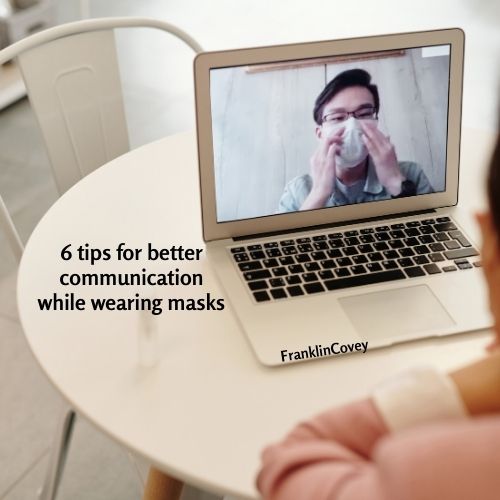
It’s hard enough to communicate effectively at work under
normal circumstances. Today, wearing masks for public
safety is a fact of life, but at work it can lead to a steady
stream of puzzled looks and “Sorry, what was that?”
responses as people struggle to hear and be heard.
One employee who is hard of hearing told us: “The rest of
the world is getting a glimpse into some of the challenges I
deal with every day.” And for those who have hearing loss
(approximately 12% of the U.S. workforce) or face
language barriers, masks can make a challenging situation
even tougher.
Thankfully, there’s plenty that you and your team can do to
minimize mask-related communication frustrations — for
yourselves, your colleagues, and your customers.
- If possible, avoid using masks that heavily muffle or distort your voice.
Not all masks are equal when it comes to interfering with your speech. For example, surgical masks, which are less
likely to absorb sound or restrict your jaw and lip movement, have been found to have a minimal effect on others’
ability to understand you when you speak. Whereas masks made of thicker material or multi-ply fabric may absorb
more sound, and tighter masks can smash your nose, lips, and jaw, hampering your articulation. There are also seethrough masks that allow people to read lips and see more facial expressions.
Of course, your top priority should be wearing the type of mask prescribed by your organization and health officials.
But if you have discretion, consider holding a team discussion about what type of mask would work best in your
situation for both safety and communication. Encourage people to wear that type and, if possible, keep a few spares
at your workplace.
Note: This article does not cover wearing masks for safety. See World Health Organization guidelines for when and
how to use masks to prevent the spread of COVID-19. - Know your speaking tendencies — and adjust as needed so that you can be better
understood in a mask.
Do you tend to talk to people while you’re looking away — maybe at your phone or screen? Or while you’re seated
and they are standing? Do you mumble? Does your voice trail off in order to open the floor to feedback or
questions? Without a mask, common habits like these may not cause comprehension issues, but they likely will
when you’re wearing one.
2/4
If you can’t easily identify your habits, ask your colleagues about times when they’ve had trouble hearing or
understanding you. Based on what you learn, consider:
Speaking while facing the other person and making eye contact
Speaking on the same physical plane as others — with everyone either sitting or standing
Speaking slowly and clearly articulating words (without overdoing it — you don’t want to sound like you’re
talking to an infant)
Projecting your voice as if you’re giving a presentation
Maintaining your voice volume through the end of your sentences
And if some of your direct reports have speaking habits that make them hard to understand, consider giving
feedback on what you notice, explaining the impact it’s having on team communication. - Develop strategies to address your team’s most common communication difficulties.
What specific issues have emerged since your team started wearing masks? It’s easy for people to get annoyed and
say, “We just can’t communicate in masks!” But if you and your team take the time to identify everyone’s new
challenges, you’ll be better able to come up with creative solutions. For example:
Challenge: Your team is mishearing customer orders.
Possible solution: Establish a standard practice of repeating back orders to be sure they are correct.
Challenge: Customers are mishearing your team’s instructions.
Possible solution: Create a sign or printout with key instruction points, so customers have both verbal and
visual explanations.
Challenge: People are frequently not understanding or mishearing certain words that your group uses often
— for example, unfamiliar words, such as business jargon, or word sounds that are hard to distinguish (“sh”
and “th” can sound the same)
Possible solution: Agree to use common words and substitutes with more distinct sounds (e.g., “hope”
instead of “wish,” which can sound like “with”).
Challenge: In crowded, noisy workplace environments, team members struggle to understand one another
while wearing masks.
Possible solutions: Use basic sign language signs or develop a few hand signals to communicate common
questions or responses. Or, if you have the space, designate a quiet zone in a side room or outside area where
people can talk more easily.
Check in with your team periodically about how well your solutions are working and adjust as needed. Also, keep in
mind that challenges may evolve as your work environment changes, so you may need to devise new tactics if, say,
your company adds or removes plexiglass barriers or changes the flow of foot traffic in your office. - Have back-up tactics you can try when masked communication isn’t working.
Even with proactive strategies in place for clear communication while wearing masks, you’ll still have some
miscues, especially if your situation includes compounding factors like a loud environment, unfamiliar accents, or
people with hearing loss.
To avoid frustrations, try tactics like these — either using them yourself or asking the person you’re struggling to
hear to try them:
3/4
Instead of repeating a point, rephrase it. When there’s a misunderstanding, repeating the exact same words
can cause the exact same issues again. Try instead, “I’m sorry, I didn’t hear that. Could you please try saying
it another way?” or “Let me try saying that another way” — the new sounds and new context might be
enough to make the message click.
Try again using shorter, simpler sentences. When people speak lots of words in a stream of consciousness
or use very complex sentences, it’s easy for listeners to lose the point partway through. If someone confuses
you with a complicated message, try asking, “Could you please explain that again, one step at a time?” And
to repackage your messages, share a small piece, pause to allow your listener to confirm understanding or to
ask for clarification, then share the next piece. For example: “The primary issue is X. [brief pause] It’s causing
Y to happen. [brief pause] I recommend Z.”
Keep a notepad nearby or use a cell phone to write out messages. If verbal communication isn’t working,
why not try written? Expressing your message may take a minute or two longer, but you’ll hopefully do it
only once. - Verbally check in about how people are doing, rather than relying on reading their
faces, voices, and/or body language.
Most people don’t realize how much they rely on nonverbal signals to read others’ emotions. When someone
approaches you with a smile, you read them as happy and expect a positive interaction. But when you have access to
only part of a person’s face and their speech is muffled, it can mess with your ability to read signals. For example,
some research suggests that without the visual cues of the mouth, people may confuse happiness for disgust. Or you
may think that someone is angry because they’re speaking loudly, when they’re just trying to make sure you hear
them.
Rather than using partial information to make possibly wrong assumptions, verbally ask the person a question about
how they’re doing in order to fill in the blanks. This could be as simple as greeting a customer with “Were you able
to find everything today?” Or you might offer your read of a direct report’s state of mind so that they can either
confirm or clarify (e.g., “That sounds frustrating …” to which the person might respond yes or “Oh, it hasn’t been
too bad”). Then you can calibrate your response accordingly. - Find alternate ways to send positive signals (which masks can mute).
Of course, when you wear a mask, your smiles go unseen, too. So, it may be no surprise that research on patient
perceptions of healthcare professionals suggests that they view mask-wearing doctors as less warm and empathetic
than those not wearing masks.
To compensate for this mask effect and ensure that your team expresses the positivity they actually feel, you could
suggest that people:
Wear positive messages on their masks or name tags. For customers, you might write “I’m here to help” or
add a big smiley face. Or, if your team interacts mostly with one another, consider allowing them to
personalize their look with a favorite image or graphic (as long as the masks still meet safety guidelines and
the image is appropriate for your workplace).
Be intentional about using positive body language. This could mean giving friendly waves to greet people
or thumbs-up signals to show agreement. Or, if you’re a free-spirited team, you could urge people to do a little
dance (or a big goofy one) when things are going well.
4/4
© 2020 FranklinCovey, All Rights Reserved






